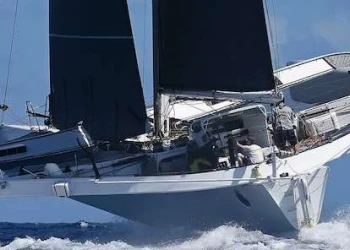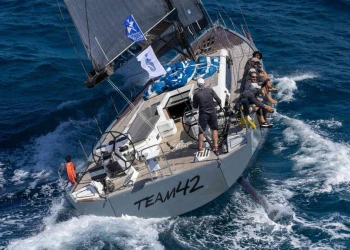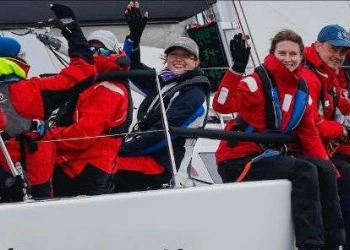
Volvo 70 I Love Poland leads the Roschier Baltic Sea Race © Janis Spurdzins
Roschier Baltic Sea Race, Day 2: beautiful and complex
The fleet in the Roschier Baltic Sea Race made good progress on the first night racing west towards Stockholm. Just over 15 hours into the 635-mile race, Volvo 70 I Love Poland had raced nearly 200 miles and was the first to round the Almagrundet Lighthouse outside the Stockholm archipelago. In contrast, the smallest boat in the race; Finnish H-323 Silver Moon II had sailed 90 miles with 540 miles to go to the finish the Roschier Baltic Sea Race.
During the first night, a light to moderate southerly breeze had given relatively fast reaching conditions for the 27 teams in the race. However, a northerly breeze has developed in the Gulf of Bothnia, producing a convergence zone of extremely light wind. This is forecast to extend across the rhumb line to the east, slowing the progress of the chasing pack behind the front runners. This band of light breeze is significant, but the complex weather scenario will create plenty of slides and speed-bumps before the race is over.
"Conditions are very changeable on the Baltic Sea," commented Konrad Lipski from on board race-leader I Love Poland. "We managed to set our optimal sail configuration after the start and thanks to that we took the lead. Now we have started the most unpredictable part of the race." I Love Poland's navigator Lipski has raced thousands of miles on the Polish Volvo 70, but most of the crew are talented dinghy sailors that are new to offshore racing. "There is a good atmosphere on board; the first night was quite predictable in terms of the weather so we were able to rest. However, we are fighting for every meter and six sail changes are already behind us, and a few more are being prepared for the next hour! We are just past the lighthouses near Sandhamn and we are racing towards Gotland."

IRC Zero
I Love Poland skippered by Grzegorz Baranowski passed the Almagrundet Lighthouse 25 minutes in front of VO65 Ambersail 2, with American skipper Clarke Murphy at the helm. Volvo 70 GP Bullhound with Per Roman at the helm was just over a minute behind Ambersail 2. The front runners in the Roschier Baltic Sea Race look to be in a good breeze, posting boat speeds of over 12 knots, south towards Gotland. A terrific battle is raging for Monohull Line Honours with wind holes and a myriad of manoeuvres to come - the fight has only just begun.
After 15 hours of racing, the overall winner of the Roschier Baltic Sea Race is far from certain, but crossing the zephyr-like conversion zone and heading south is a major factor. I Love Poland is estimated to be leading the race after IRC time correction from GP Bullhound and Ambersail 2. Tilmar Hansen's German TP52 Outsider is ranked fourth and has the Almagrundet Lighthouse in sight. Outsider is undoubtedly running under Code Zero making 12 knots, approximately two hours from rounding the lighthouse and turning south.

IRC One
Perhaps Arto Linnervuo, skipper of Finnish xP-44 Xtra-Staerk is in conversation with the Finnish Goddess of wind Tuuletar. Xtra-Staerk leads IRC One on the water, as they have from the start. The highly competitive fleet in IRC One had all worked north of the rhumb line during the night, but at approximately 0900 UTC on Day Two, Xtra-Staerk took a hitch south. A pack of boats have continued northwest led by Martin Buck's German Pogo 44 MarieJo and Niclas Heurlin's Swedish Farr 400 Wetjob. Ed Bell's British JPK 1180 Dawn Treader has followed Xtra-Staerk's dive south and Dawn Treader is estimated to be leading IRC One after time correction by an hour and 20 minutes.
IRC Two
Margus Uudam's Estonian J/112 Nola leads on the water, but only just. Olof Granander's Swedish First 40.7 Embla has covered the same distance but on a more northerly trajectory. Five miles behind is the highly impressive Finnish J/109 Irie, raced Two-Handed by Julius Haartti & Sanna Moliis. The leaders on the water in IRC Two will be aware that the wind is due to fade in the convergence zone and the boats behind will close the gap. However, strategy is still very much at play. The leading teams are north of the rhumb line hoping to get into the new northerly wind before their rivals.

IRC Two-Handed
J/109 Irie is estimated to be leading the double-handed class after IRC time correction, with Paer Lindfors & Nadine Kugel Swedish Albin Nova Team Mobline ranked in second. Anders Lundmark & Louise Edgren racing Danish Figaro 2, The Spirit is ranked in third and is the most northerly of the class.
J/109 Irie is raced by Helsinkians Sanna Moliis & Julius Haartti; the pair raced a classic boat before purchasing the J/109 Irie last year. "Our previous classic boat had large sails, running backstays and a heavy spinnaker pole; not the easiest to sail double-handed! We have been sailing the J/109 Irie in short double-handed races so we have really been looking forward to the Roschier Baltic Sea Race. We love to keep up the boat speed and will focus all the way round, and of course enjoy the ride and have fun!"

Janne Kjellman's Finnish TS42 Squid was passing the islands of Skärgårdshavets National Park on the second day of racing © Skärgårdshavets National Park
The beauty of the Baltic Sea
The beauty of the Baltic Sea is stunning. Janne Kjellman's Finnish TS42 Squid, the only multihull in this inaugural Roschier Baltic Sea Race has raced 144 miles. The performance ocean-going catamaran has simply to finish to claim the Baltic Trophy for the MOCRA Class. Gliding along on flat seas Squid is passing the islands of Skärgårdshavets National Park, most of which are uninhabited and only accessed by boat.
The official race supporters of the Roschier Baltic Sea Race are: The City of Helsinki; The Nyländska Jaktklubben (NJK), Finnish Offshore Racing Association (AMP); Helsingfors Segelklubb (HSK); FINIRC and the Xtra Stærk Ocean Racing Society.





